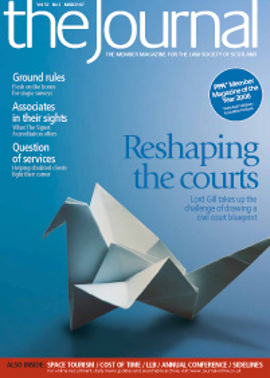"Lossiemouth, we have a problem"?

Situated on the Moray Firth coast, some five miles north of Elgin, Lossiemouth may seem an unlikely candidate for the centre of the UK’s high-tech space programme. Originally owing its existence to Elgin’s need for a port to service its trade, today the town is no stranger to the roar of powerful engines due to the presence of nearby RAF Lossiemouth. Yet the skies above Lossiemouth could soon resound with the roar of commercial spacecraft ferrying passengers on a brief flight into space from “Spaceport” Lossiemouth if Will Whitehorn, the President of Richard Branson’s Virgin Galactic, gets his way.
Giving evidence to the Select Committee on Science and Technology’s inquiry into the UK’s space policy on 21 February, Will Whitehorn urged the government to put in place a legal and regulatory regime that will foster a viable commercial space tourism programme in the UK and to allow Virgin Galactic to launch sub-orbital flights carrying passengers from Lossiemouth or from St Mawgan in Cornwall.
The flight now boarding
If the prospect of Spaceport Lossiemouth seems implausible to you, then it’s time to get with the (space) programme. Space tourism became a reality on 28 April 2001 when Dennis Tito, an American businessman (read: multi-millionaire) took a cruise arranged by space tourism company Space Adventures to the international space station aboard Russian Soyuz TM-32. Dennis Tito orbited Earth a total of 128 times and spent 7 days, 22 hours, 4 minutes in space and a reported $20 million for the privilege.
Although there have been at least three more space tourists since Mr Tito, at that price there cannot be many takers. Space tourism for the common man (or woman) only began to look truly plausible on 4 October 2004 when test pilot Brian Binnie flew SpaceShipOne’s second Ansari X Prize flight to an altitude of 112km to win the $10 million prize and the distinction of being the first Scot in space. The X Prize was modelled on 20th century aviation prizes such as the $25,000 Orteig Prize, which was won by Charles Lindbergh when he flew the Spirit of St Louis solo across the Atlantic in 1927.
SpaceShipOne is a spaceplane which is transported to high altitude by a specially designed jet aircraft. Registered with the US Federal Aviation Authority as a glider, SpaceShipOne’s achievements are more comparable with the X-15 rocket plane of the early 1960s than with the Space Shuttle.
Virgin Galactic was quick to negotiate an exclusive licence to exploit SpaceShipOne’s technology, which is owned by famous aircraft designer Burt Rutan’s company, Scaled Composites. Now plans for the design and construction of the SpaceShipTwo prototype are well underway.
Costs down to earth?
Since mid-2005, Virgin Galactic has been selling tickets for a two-and-a-half hour long sub-orbital space pleasure cruise for the princely sum of $200,000, around 100 times less expensive than Dennis Tito’s ticket on Soyuz TM-32, but still well beyond the budget of most people. However, in his evidence to the Select Committee, Virgin Galactic’s Will Whitehorn said that “within five years we can get the cost down to $75,000 and eventually down after nine years to $50,000, which is £25,000”. That’s still very pricy for a mere three minutes of weightlessness, some might say, but there are people out there with money to burn who may now legitimately consider whether they would prefer to go on that luxury six month round-the-world cruise or to become an astronaut.
Legal gravity
Virgin Galactic’s space flights will initially launch from the USA for two main reasons: one, the proprietary technology in the spaceplane was developed in the USA and is therefore subject to US export control regulations, specifically the International Traffic in Arms Regulations (“ITAR”); and two, the fact that the USA has been quick to create a stable and supportive regulatory framework for emerging commercial space industries such as space tourism. For example, the Office of Commercial Space Transportation (“AST”), a branch of the US Federal Aviation Administration, regulates the commercial space transportation industry to the extent necessary to ensure compliance with certain international obligations and to protect public health and safety, the safety of property and the USA’s national security and foreign policy interests. The AST operates a licensing regime in accordance with the Commercial Space Launch Amendments Act passed by the US Congress in 2004. The AST also has a legal mandate to encourage, facilitate and promote commercial space launches by the private sector and has a role in recommending appropriate changes to US Federal law.
In the UK the Outer Space Act 1986 provides a framework for licensing UK individuals or organisations who launch or procure the launch and/or the operation of space objects or carry out other activities in outer space, whether this is done in the UK or elsewhere. Before granting a licence, the Secretary of State for Trade and Industry requires to be satisfied that the activity will not jeopardise public health or the safety of people or property. The current regime is viewed by firms such as Virgin Galactic as a hindrance to it operating its space tourism flights in the UK. Virgin Galactic will now get its opportunity to make detailed submissions regarding the kind of licensing regime it would like to see to the British National Space Centre, which has been tasked by the Department of Trade and Industry to consult stakeholders on how the Outer Space Act 1986 and its licensing regime could be updated.
The State Government of New Mexico has led the way in offering public incentives to emerging space companies through its development of “Spaceport America” and the Swedish Government is following suit. If space tourism from the Moray Firth is to become a reality, the UK Government will have to create a favourable policy and regulatory regime and consider investment in Public-Private-Partnerships for infrastructures (such as Spaceport Lossiemouth itself) which can be used by the private sector for commercial space activities. The UK Government will also need to bring whatever influence it has to bear to allow technology transfers to the UK that are currently being prevented by the USA’s arms export control regime (we are an ally, after all). Although space policy is a reserved matter under the Scotland Act 1998, there is no reason why the Scottish Executive cannot get involved in devolved areas.
Economic lift-off
The potential benefits to the Scottish and UK economies in encouraging this new industry are clear. An Oxford Economic Forecasting (“OEF”) study has shown that the UK space sector contributes approximately £6.8 billion and 70,000 jobs to UK GDP once direct, indirect and spillover effects are taken into account. The industry is six times more R&D intensive than the UK economy as a whole, and productivity (value added per employee) in the UK downstream sector is £160,000 per worker compared with an overall UK average of £36,000. A thriving UK commercial and civilian space sector will contribute to the Exchequer through tax revenue, promote the development of bespoke intellectual property by UK firms, reduce the “brain drain” of workers in the industry to the US or wider EU, and could reduce or even reverse the decline in the uptake of science and engineering courses in secondary and tertiary education.
And of course, it rekindles our childhood dreams of one day becoming an astronaut.
Douglas McLachlan is a solicitor with Biggart Baillie’s IP & Technology Group in Glasgow e: dmclachlan@biggartbaillie.co.uk
SPACE TOURISM: SOME FACTS
- American businessman Dennis Tito became the first space tourist in 2001 when he paid a reported $20 million for an eight day trip to the international space station
- Virgin Galactic is now selling tickets for a two-and-a-half hour sub-orbital space pleasure cruise from the USA for the sum of $200,000
- New Mexico and Sweden are offering public incentives to emerging space companies
- The legal regime in the UK is the Outer Space Act 1986, which is regarded as a hindrance by companies wishing to offer space tourism flights
- The UK space sector contributes approximately £6.8 billion and 70,000 jobs to UK GDP when indirect effects are taken into account
In this issue
- A look in the mirror
- A welcome review
- Squaring the circle
- Profitability and financial structure
- Access-ability
- Culture change
- Practice? What practice?
- Signet badge takes wing
- Four in one
- Appreciation: Angus McLean
- In on the Acts
- "Lossiemouth, we have a problem"?
- Flagging up VAT
- In the family way
- Practice inside out
- Shape of things to come
- Breaking down a brick wall?
- Playing by the rules
- Scottish Solicitors' Discipline Tribunal
- Website reviews
- Book reviews
- Funny thing
- PIPs' hour approaches
- Enabled in the housing market
- Registers refresher






